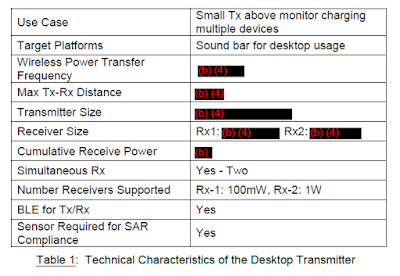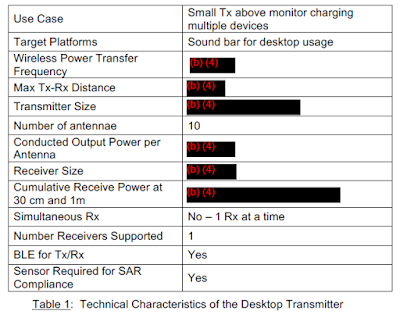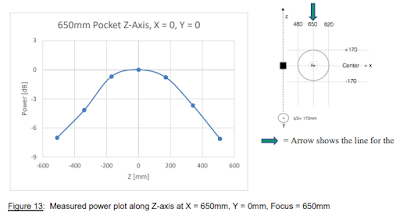One of the pleasures of writing this blog is in the communications with engineers and scientists who are experts in their respective fields, and I get to learn from private email discussions, or have a great sounding board to bounce theories back and forth with. Following my recent posts on the Energous FOIA documents, one contributing reader let me know they had also directly requested those documents on Energous, and received a batch of redacted emails that had some new ones not in the collection that had been previously available, which led to some interesting exchanges - so thank you for that.
These documents cover an earlier time period from December 2014 to March 2017, with at least one of the email threads having a full year gap in the middle. Those of you who would like to see the new documents in full, email me and I'll send them, or you can contact the FCC yourself and say "I ask for the responsive records for FOIA 2018-000342", and start with the FCC FOIA page here.
These documents cover an earlier time period from December 2014 to March 2017, with at least one of the email threads having a full year gap in the middle. Those of you who would like to see the new documents in full, email me and I'll send them, or you can contact the FCC yourself and say "I ask for the responsive records for FOIA 2018-000342", and start with the FCC FOIA page here.
There are no stunning technical revelations in here, but there are some key points from earlier that seem to be confirmed. For those who don't want to read the details, the main takeaways are that:
- Switch from 5.75 GHz to 915 MHz seems to have happened late summer 2016
- The "local" RF power issue to get Part 18 seems to be resolved in Oct/Nov 2016
- Reduction of power at receiver to well below 1 Watt seems to happen at end of 2016
- Explicit admission of single device charging occurs in early 2017
These four items combined are likely to have a significant impact on the practicality of the device - huge "pockets" of energy and poor steering, highly limited operating range, delivered power below useful levels for most devices, and only one device at any time. The entire system was on shaky ground to begin with, IMO, and these changes made what I would consider a terrible product far, far worse. In future posts I may compare the dates of these changes, that have quite an impact, with statements from Energous at the time. A publicly traded company must be very careful in what it tells the public.
"Throw it at the wall and see what sticks"
I guessed that Energous were just refiling applications again and again, each time making what minimal changes they thought might get them through, and relying on the FCC to guide them in changes, or perhaps simply to give up and so win through attrition. These documents seem to reinforce that with five face-to-face meetings between June 2016 and March 2017, and nine OET Submissions between August 2016 and March 2017. If we look at the times they submitted, there are some key changes at various dates. Unlike most situations where a company has a product that has to meet minimum specs to satisfy customer demand, it's obvious that there is no aspect of the design that will not be sacrificed in order to get Part 18 approval, no matter how pointless the resulting 'product' is. I list the physical meetings and OET submissions at the base of this article. Key changes are:
- 5.75 GHz to 915 MHz change occurred between June 23rd 2016 (experimental licence) and October 17th 2016 (Document 59)
- Part 18 "Unlimited Power" appears to have been resolved between October 17th 2016 (Doc 59) and November 8th 2016 (Doc 58), possibly at the October 26th face-to-face meeting. "Local" and "unconstrained" RF energy issues do not arise anymore. Note this does not resolve safety issues, such as SAR
- Two Receivers Down to One happens between August 23rd 2016 (Doc 61) and December 12th 2016 (Doc 56). No reason given, perhaps complex SAR measurements
- Drop Below 1 Watt Charging Claim happens between August 23rd 2016 (Doc 61) and (likely) December 12th 2016 (Doc 56) or (definitively) March 28th 2017 (Doc 5)
- Change from 10 Antenna to 12 happens between December 12th 2016 (Doc 56) and February 26th 2017 (Doc 1)
- Change from Sound Bar to Angled Sound Bar happens between December 12th 2016 (Doc 56) and February 26th 2017 (Doc 1). May just be a description change, but coincides with # of antenna change. Energous still demonstrating 'abandoned' straight bar as of January and June 2017.
- Change to Charging a Single Device is in February 26th 2017 (Doc 1), although it was obvious even in earlier submissions this was likely. May be a move to "time sharing" charging multiple devices, reducing already low charge rate to each
No significant changes seem to have occurred between March 2017 and approval in December 2017, which surprised me as the system and performance were so basic that I thought they had to have rushed it, but it seems they had most of a year.
Given the above, it doesn't appear that the change to 915 MHz, at least by itself, fixed the Part 18 issues as that change had occurred by October 17th 2016, while Part 18 questions were still being asked. It could be that the change occurred and it just took time to get that accepted as sufficient for Part 18, or it could also mean that they still had not satisfied SAR safety and did not start lowering the power output until December 2016/March 2017. This also means that Energous knew the mid-range transmitter would be incompatible with the higher frequency mini-WattUp, or have 1 Watt charging, while promoting licencing deals with the likes of Myant. I wonder if Myant knew?
The most important change that allowed for Part 18 approval seems confirmed now to be the requirement for "local" RF energy, and that such energy is never "uncontained". I've suggested this may restrict any such system from working in the far field (which for an array this size is around 1 meter at 915 MHz), but may also be restricting the system from working in the near field where there are multiple "pockets of energy". This would then be a second need for the safety cutoff system that prevents SAR limits being exceeded. If this is the case, even without SAR limits the system would be constrained to the 50 cm to 1 m range it currently is, and makes questionable the claims of Energous' CEO that power limits could be raised by extending this keep-out zone.
This gives a possible explanation as to why 5.75 GHz was not used (beyond the simple FCC statement of "no destroying WiFi"), as the far-field boundary moves much further out and the "pocket" of energy gets smaller in theory - that any close in operation that would be needed would be in the near field with many maxima and minima, with potential for further maxima beyond the charging location. Either that or such a system would require too many antenna and electronics too precise for Energous to want/be able to build. There's still not enough information to resolve this question, but more pieces are beginning to fall into place.
If that's the case, it doesn't bode too well for Ossia, who recently claimed a shift to 5.8 GHz. While they have a 2D array and can probably dynamically alter the transmit aperture, say to a 30x30 cm square for a 1 meter far field. There would be a pretty reasonable number of elements in that, assuming 1/3 wavelength pitch (around 17 by 17, or ~300). Quite how they overcome the SAR and safety issue and still get reasonable energy out, I'm not sure - I still only see this working for IoT devices at exceptionally low power. Searching on the FCC website though, I can't find grantee code for Ossia - it's as if they've never interacted with the FCC on product regulation at all. Does anyone know what their FCC grantee code is?
So the outcome of this is more clarity that Energous were simply doing whatever it takes to get Part 18 approval, even if it were a product that failed to meet their original claims, and some visibility into the methods they used to slowly reduce capability, or wear down the FCC, until it was finally allowed. The "local" RF energy question seems to have been answered by placing severe restrictions on the usable range, while safety was met by reducing power again and again, retesting until it finally passed. Little by little, we're learning more about how this process was playing out in the background. I'm looking forward to the next set of revelations to narrow down what's really going on.
Oh, and Energous earnings tomorrow - odds on this ~$400m market cap company earning more than $25,000 this quarter? (My mistake, earnings at the end of Wednesday, not Tuesday! And boy was it an interesting call.)
Oh, and Energous earnings tomorrow - odds on this ~$400m market cap company earning more than $25,000 this quarter? (My mistake, earnings at the end of Wednesday, not Tuesday! And boy was it an interesting call.)
(Repeating the seemingly obligatory statement - I have no financial position, short or long, in Energous or any related company)
Below is a simply a summary of meetings and submissions to the FCC by Energous on their mid-range device. This is not intended, or likely, to be complete, just what is known at this time. I'll update with other information later.
Physical Meetings
- 8/9th June 2016 (experimental licence application)
- 27th July 2016 (Doc 61)
- 26th October 2016 (Doc 55)
- 6th December 2016 (Doc 54)
- 28th Feb 2017 (Doc 3)
Office Engineering and Technology (OET) Response Submissions
- 23rd August 2016 (Doc 61) - Still not clear that Part 18 is achievable, and claims a second receiver at 1 Watt. To get Part 18, repeatedly references "local" RF energy. Two receivers listed, one at 100 mW, one at 1 Watt - last mention of two receivers or 1 Watt. Power reported as "Number Receivers Supported: Rx-1: 100mW, Rx-2: 1W", No indication if these two receivers were on the same device, or could be separate, I expect a single device. Lists a sensor needed for SAR compliance.
- 17th October 2016 (Doc 59) - Earliest mention of the 913 MHz band in available documents. Ongoing discussion of viability of Part 18 with it clearly critical that energy be assured to be "local" and can never be "uncontained". Also see page 2
- 8th November 2016 (Doc 58) - All Part 18 discussion is dropped following Oct 26th meeting. It is never raised again in future documents. Part 18 "local" and "unconstrained" issues solved?
- 30th November 2016 (Doc 55, Page 4) refers to an OET Response on this date but not available
- 10th December 2016 (Doc 57) refers to meeting of Oct 26 and not Dec 6. Appears Energous want OET to develop new safety criteria for them. Jeff McNeil of Energous adds "Regulatory" to his SVP Ops title.
- 12th December 2016 (Doc 56) refers to Dec 6th meeting. FCC requests clarity on which of the many designs will be submitted. Table 1 lists 10 antenna and "Target Platforms: Sound bar for desktop usage". Power now reported as "Cumulative Receive Power at 30 cm and 1m: [Redacted]". Use case claims "charging multiple devices", but admits to one device at a time.
- 18th December 2016 (Doc 55) FCC request a different method of calculating SAR and measure individual antenna
- 26th February 2017 (Doc 1) Table 1 lists 12 antenna and "Target Platforms: Angled Sound Bar for desktop usage". If an actual change, a limit on phase array capability to focus? Number of antenna and description change. Use case now admits "charging single device"
- 28th March 2017 (Doc 5) - FCC still asking for single clear submission
Experimental Licence Application
- To demonstrate the technology to FCC, a 15 day experimental licence was applied for , starting June 8th 2016 for 15 days. Application is here. The details of this can be found at the FCC site here, and clearly show still operating at 5.8 GHz, with 20.4 Watts output (55.6 W ERP). Energous' next such application was for 6 days, between 6th and 12th January this year for CES, which listed the 913 MHz band with 30 W ERP.







